The Azores islands offer pure nature, and as some people always feel the urge to compare places with each other, the archipelago is often referred to as the Hawaii of Europe. As a matter of fact, Sao Miguel, the largest one of the Azores, offers a comprehensive variety of the best things to see and do in a few days in this piece of paradise located about halfway between Europe and North America.

Basically, all travelers of the Azores visit São Miguel, and many of them stay exclusively on this most prominent one of the islands. And indeed, you’ll find all the attractions the archipelago has to offer here in one spot: breathtaking natural beauty, outdoor adventures, and rich cultural experiences. Yet, despite its growing popularity, São Miguel remains relatively unspoiled by mass tourism. It maintains an authentic, relaxed atmosphere that makes it perfect for those looking to escape the hustle and bustle and reconnect with nature.
São Miguel
São Miguel, the archipelago’s main island, belongs to the so-called eastern group and is practically the entrance gate to the Azores. Hence, it’s not surprising that it is the most developed destination for tourism. This being said, São Miguel is still a great destination for those who want to enjoy nature responsibly, as the Azores are committed to sustainable tourism in order to preserve their pristine environments.
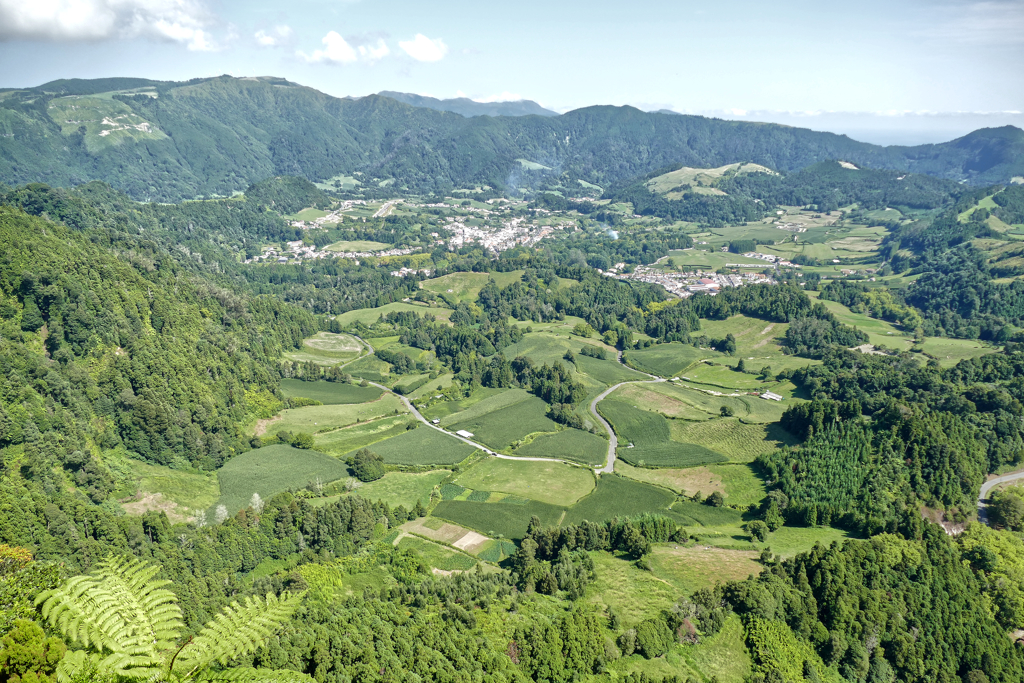
The island of São Miguel is best known for its mesmerizing scenery, hot springs, and lakes in former volcanic craters. This and many other unique features make the island an ideal hideout for people who enjoy nature and are into hiking between blue and white hydrangeas, swaying palm trees, pristine lakes in lava hollows, pineapple plantations, and the only tea plantations in all of Europe.

In addition to tourism, dairy farming and the cultivation of fruit, especially pineapples, play a major economic role for São Miguel today. Furthermore, Chá Gorreana and Chá Porto Formoso are the only two tea plantations in the European Union.
Agriculture And Cattle Breeding
The cultivation of tea, as well as pineapples, for that matter, was an emergency solution when the orange trees, which in earlier times had been the island’s most important source of income, were wiped out by disease in the 19th century. As an alternative, the focus was now on cultivating these two very labor-intensive plants. So don’t be surprised that the pineapple grown on small plantations costs two to three times as much as the one in your local supermarket. It is almost an artisan handcrafted piece.

Nevertheless, since it is not possible to make money in the long term with elaborately manufactured individual pieces, the main focus is on cattle breeding. Therefore, São Miguel has almost 2.5 times as many cows as two-legged residents. Amidst the lush meadows, natural springs, and endless green pastures, the cows on São Miguel live their best life. Most of their milk is exported. However, the locals make fantastic-tasting cheese from the share of milk that they keep.
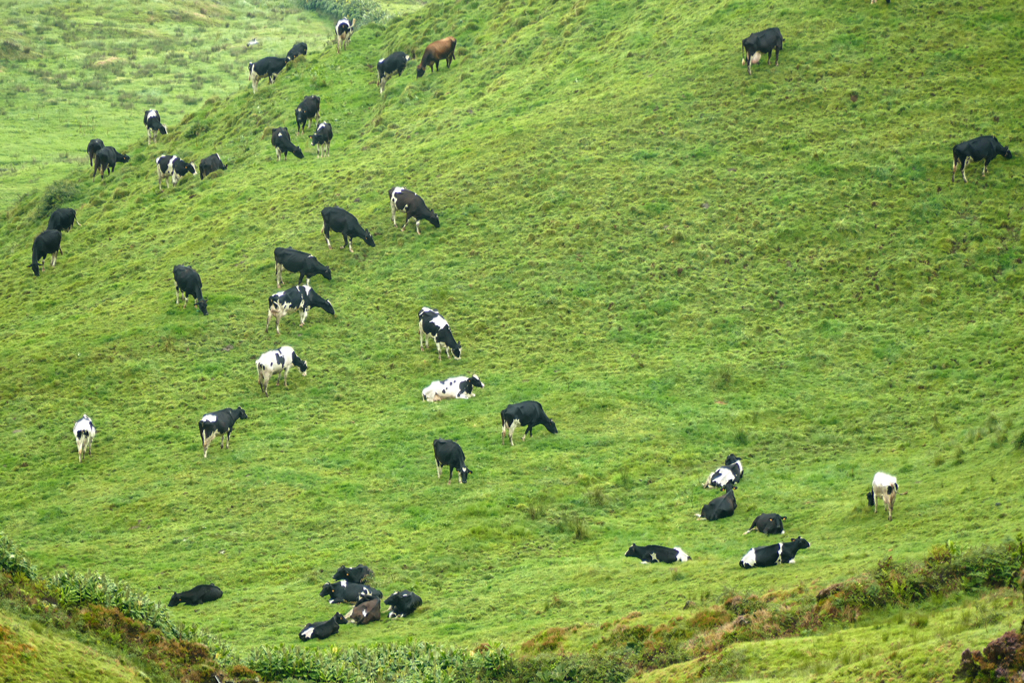
Surprisingly, the importance of fishing on the island is declining. Commercial whaling continued in the Azores until the 1960s. And strictly speaking, those gentle giants still provide good income today, but fortunately, now in the form of bloodless whale watching.
Don’t You Miss It
São Miguel is famous for its volcanic landscapes, particularly Sete Cidades, an iconic twin lake in a huge crater that offers spectacular views from various viewpoints. Also, the serene Lagoa do Fogo in the middle of a so-called caldera is known for its untouched beauty. As a matter of fact, there is an extensive network of hiking trails through lush forests, along cliffs, and around volcanic craters. And since São Miguel enjoys a mild, temperate climate all year round, including the winter months, it is a perfect destination for outdoor activities and sightseeing.
The island has several geothermal areas where you can relax in natural hot springs. In Furnas, you can even witness the traditional method of cooking food in volcanic steam vents. Make sure to sample the famous Cozido das Furnas, a slow-cooked stew prepared underground using geothermal energy!
Going South: Ponta Delgada, the Alluring Capital
The Portuguese King Manuel I founded Ponta Delgada in 1499. The settlement around a monastery with an attached hospital and a harbor grew rapidly in the following years. The importance increased with the headquarters of the island administration. In 1522, construction began on the Forte de São Brás to protect the city against pirate attacks.
The city’s prosperity grew with the establishment of orange orchards at the end of the 18th century. Numerous stately houses, streets, a cemetery, as well as gardens and parks in the English style still bear witness to this time. Progress was unstoppable: the first street lighting powered by fish oil was introduced in 1839, and the first car followed in 1901.
As mentioned, São Miguel is the most popular of the nine islands, and Ponta Delgada, which has been the seat of the regional government of the Azores since 1975, is an excellent location and an ideal base from which to explore the island. The fact that the city also has the most important airport in the archipelago makes it the most substantial hub. However, the city itself also has some places worth visiting in its very center, as well as in the immediate surroundings.
Campo de São Francisco
Since 1552, the Forte de São Brás fortress has protected the islanders from the once-regular pirate attacks. It is located south of Ponta Delgada’s Praça 5 de Outubro at the western end of the harbor area, and therefore, a great spot from which to explore the city. Today, the bastion houses the Museu Militar dos Açores.

Three churches frame the Praça 5 de Outubro, which is better known by its former name Campo de São Francisco.
The Igreja de São José on the west side once belonged to the Franciscan monastery Convento de Nossa Senhora da Conceição. This largest church building in the Azores was built over a sixty-year construction period in the 16th century.

Also, you can admire a stunning example of the city’s artistic black and white cobblestones using the island’s own basalt as well as granite from the Portuguese mainland.
Later, the Nossa Senhora da Dores chapel was added to its left side. It is a prime example of baroque architecture in the Azores. Until 1864, the chapel was the starting point for processions in which believers scourged themselves with whips in order to obtain forgiveness for their sins.
Convento and Igreja da Nossa Senhora da Esperança
The then-governor Rui Goncalves da Camara commissioned the construction of the nunnery Convento da Esperança with the monastery church Igreja da Nossa Senhora da Esperança on the north side of the square in the middle of the 16th century. A dozen nuns still live in this convent today.

Don’t forget to visit the so-called Roda in the inner courtyard. A Roda is actually a baby hatch. This device has been around since the 12th century. They should help prevent the abandonment or killing of newborns.

The Roda at the Igreja da Nossa Senhora da Esperança is used for a kind of lottery: you place a donation into the wooden device and turn the wooden shelf. On the other side, a mysterious person takes your donation and places a small gift in the Roda. This can be a religious brochure, an embroidered cloth, or other small things.
I’ve never seen anything like this before and was very impressed. You should definitely check it out!
Praca de Gonçalo Velho
The actual city center, however, is around the Praca de Gonçalo Velho. It was named after the discoverer of São Miguel, Portuguese monk and Commander in the Order of Christ, Gonçalo Velho Cabral.

In the square’s vicinity are some of the city’s most prominent landmarks, like the town hall from the 17th century, the 18th-century gates featuring ornate archways, as well as fountains and statues. Obviously, you’ll find all the major bank buildings here as well as a wide choice of shops, restaurants, and cafés.
Also, Ponta Delgada’s main church, Igreja Matriz de São Sebastião, is located here. It was initially constructed as a small pilgrimage chapel for São Sebastião, the island’s first patron saint, as a thank-you for the help against the plague that raged on the island in the early 16th century.

In the 18th century, it was redesigned and expanded to include Manueline and Baroque-style portals.
Fun Fact
The church tower of the Igreja Matriz de São Sebastião is the only church in the city with a clock!

Largo do Colégio
The Igreja de Todos-os-Santos, better known as Igreja do Colégio dos Jesuítas, crowns the Largo do Colégio located north of the Praca de Gonçalo Velho.
The building has a richly decorated baroque facade, which undoubtedly makes it the most beautiful structure in the city. The foundation stone was laid on All Saints’ Day in 1592. Eventually, it has been rebuilt and renovated several times.

The church was supposed to become part of the Jesuit college, but the Jesuits were expelled on the orders of Sebastião José de Carvalho e Melo, the Marquis of Pombal. You can find out who Marquês de Pombal was and what role he played in Portuguese history in my post Best of LISBON – also for solo-travellers.
Next to the Igreja do Colégio dos Jesuítas are the library and the city archive with many historical documents from the city’s history. You will also find the Museu de Arte Sacra here.
Museu Carlos Machado
Just two blocks west of the Igreja do Colégio dos Jesuítas is the most important museum in the Azores. The rector of the Liceu Nacional Carlos Maria Gomes Machado founded it in 1876.
Since 1930, the Museu Carlos Machado has been housed in the former Convento de Santo André monastery from the 16th century. Manifold aspects of traditional Azorean life are presented with a variety of exhibits. The exhibition of works by local artists complements the collection.

The exhibition of contemporary artists is housed behind the main building in the so-called Núcleo de Santa Bárbara.
The museum is open from Tuesday to Sunday between 9.30 a.m. and 5.30 p.m. and the general entrance fee is only 2 €uros. On Sundays, visits are free.
São Pedro
Also worth mentioning, as well as visiting, for that matter, is the Igreja de São Pedro located further west near the hotel area. It was built in the first half of the 18th century in the Baroque style on the foundations of a chapel that was destroyed in an earthquake and is now the parish church of the district of the same name.

The high altar with gilded wood carvings can be admired in the single-nave, octagonal church interior. There is also the portrait of Nossa Senhora das Dores, which is considered the most beautiful Baroque sculpture in the Azores.
Piscinas
The only thing that is a little lacking on the island of São Miguel is beach life. There are occasionally short stretches of sandy beach, but for the most part, the coast is rocky and volcanic.
But that doesn’t matter because the clever islanders made a virtue of necessity and converted the lava pools into swimming areas. Stairs and permanently installed railings ensure safe entry into the pools, where you can then swim to your heart’s content in the pure seawater. The walls of the reservoirs protect bathers from the surf of the sea. There is also a lifeguard on duty from 10 a.m. to 7 p.m. And the best part is that these natural swimming areas are completely free of charge! However, you have to accept the small inconvenience of having to spread out your bath sheet on the stone floor.

There is also a paid pool right next to the natural swimming pool, including slides, loungers, freshwater showers, changing rooms, and other amenities. The entrance fee is only 2.70 €uros, if you want to use a lounger with a mattress, you have to pay another 2.50 €uros. Here, too, you swim in seawater, but in addition, it is chlorinated. Also, there is a small snack bar right next to the swimming pool.
Gardens And Plantations
Although Ponta Delgada is the largest city in the Azores, it ultimately has less than 70,000 inhabitants. This makes the number of parks, botanical gardens, and other greeneries even more impressive.
All gardens are located further north of the city center. You have to keep in mind that this area was the rural hinterland at the time of construction in the 19th century. The city’s large botanic gardens were laid out according to English models. They marked the transition between urban and rural areas.

Their founders, António Borges, José do Canto, and José Jácome Correia, were driven by a great passion for horticulture and went down in the city’s history as so-called gentlemen farmers.
Botanic Gardens
The Jardim Botânico António Borges was built between 1858 and 1861. It was named after its founder, businessman and politician António Borges da Câmara Medeiros, obviously.
On the premises, you will find winding paths between native, often endemic plants. A maze of caves, stairs, and tunnels made of red lava stone makes the visit an unexpectedly exciting experience.
You can visit the garden every day from 9 a.m. until 6 p.m. for free.
In the mid-19th century, José do Canto planted thousands of species in his garden north of the center of Ponta Delgado. Today, the enchanting Jardim José do Canto is appreciated as an urban oasis. However, it is not just a popular place for relaxation but also a venue for cultural events.
The garden also houses the Palácio José do Canto, which is one of the last Palladian buildings from the 20th century and the largest and most important of its kind in São Miguel.
For 5 €uros, you can visit the garden daily from 9 a.m. until 7 p.m. On Mondays, they are closing at 5 p.m.
Next to the Jardim José do Canto is another magnificent garden, namely the Jardim do Palácio de Sant’Ana. The complex dates back to the 19th century. This is not surprising considering that this was the Azores’ Gilded Age due to the cultivation and export of oranges.

In 1977, the administration of the Azores bought the complex from the Marques de Jácome Correia for the symbolic price of the equivalent of around 80,000 €uros.
The gardens can be visited for 2 €uros from Tuesday to Sunday between 10 a.m. and 5 p.m. You must show some kind of official ID, and you’re not allowed to leave the specified route.
Parks
Apart from the spacious botanical gardens, Ponta Delgada has a number of charming small parks and leafy squares.
A particularly charming one among these parks is the Jardim Sena Freitas. It is named after an influential priest and writer from the 16th century. The garden is located where the São José Church and the first Micaelense Theater used to be. Here you can stroll around or relax on benches between various exotic plants.

Just one block north of Jardim Sena Freitas is the Jardim do Campo Mártires da Pátria. Since it is close to some of the city’s most significant buildings, it is the ideal spot for taking a break from sightseeing.
The third of my favorite gardens in Ponta Delgada is Jardim Antero de Quental. It borders directly on the Largo do Colégio and is named after the poet Antero de Quental, who was born in Ponta Delgada, obviously. Take a stroll along wide paths lined with bushes and flower beds before relaxing on the terrace of the park café and enjoying a little refreshment.
Street Art
Anda&Fala, Walk&Talk in English, was founded in the Azores in 2011. This cultural initiative promotes artistic creation on the islands of São Miguel and Terceira. Over twelve years, the project has brought together over 500 creatives from various disciplines and regions.

In 2020, Anda&Fala was able to install its headquarters in the Vaga – art and knowledge space in Ponta Delgada. Vaga is a cultural institution that promotes and supports contemporary visual art, but also performances, workshops, and artistic residencies.

Since 2023, Walk&Talk has continued as a biennial festival. This gives the organizers more time to organize and implement a program that is appealing to everyone.
The first biennale will take place in 2025.

Yves Decoster
An urban artist particularly worth mentioning is Yves Decoster. The Belgian visited São Miguel for the first time in 1982. Since he immediately fell in love with the island, he moved there for good just a couple of years later.
You don’t have to look for his now iconic heart murals. You simply find them in many, many places. And that is exactly the charm of these mostly not very spectacular images in different formats. It’s a bit like peek-a-boo: the hearts seem to appear when you least expect it. And they change and train our view of the less dazzling ones under Ponta Delgada’s walls and facades.




Yves Decoster is determined to create 1,000 hearts on the island. Only here, and nowhere else. Since street art is ephemeral, especially in such harsh climates as in the Azores, it could become a life’s task.
Going North: Beauty And the Beach
Since the distance from Ponta Delgada to Ribeira Grande is only about 18 kilometers and there is even a regular bus connection, the north coast is actually an area that you can easily visit by public transport. If you don’t have to drive yourself, you can also merely enjoy the scenic route through the island’s lush landscape.
The north coast is a stunning mix of dramatic volcanic landscapes, lush greenery, and traditional Portuguese charm. Known for its rugged cliffs, black sand beaches, and small villages, this part of the island offers an authentic experience of the Azores’ way of life. It’s a great area for hiking, swimming in natural pools, and soaking in thermal waters, all surrounded by the stunning landscapes that make the island so unique.
Lagoa do Fogo
First things first: Although the Miradouro do Pico da Barrosa, from where you have an amazing view of the Lagoa do Fogo, is only about 20 kilometers east of Ponta Delgada, there is no public bus going there. If you don’t have a car, you can always hire a cab, which will charge 27 €uros one way. Eventually, you can hike down to Ribeira Grande. It lies less than twelve kilometers north of the viewpoint.
Or you take a cab again.
Either way, you shouldn’t miss out on a visit, as Lagoa do Fogo is a crater lake located in the inner caldera of a stratovolcano. This crater was formed in 1563 after an eruption of Pico da Sapateira, which no longer exists today.

This so-called fire lagoon is located at an altitude of 575 meters above sea level. With an area of 1.36 square kilometers, it is the third-largest lake in São Miguel. Liquid carbon dioxide has been trapped in the lake, which is up to 30 meters deep, since the time of its creation. Nevertheless, fish and amphibians are able to survive in the waters.
What to Keep in Mind
As I have emphasized, even rather touristy São Miguel is by no means overrun with tourists. Therefore, the infrastructure is not always aimed at visitors. For instance, there is hardly any parking space next to the viewpoint. However, a shuttle bus takes those who come by rental car from the parking lot up to the outlook.
Those with enough time and stamina can hike down to the lake. However, keep in mind that swimming in Lagoa do Fogo is not permitted.
Ribeira Grande
Now, as I said, getting from Ponta Delgada to Ribeira Grande is a very easy endeavor. It is the largest city in the north of São Miguel and is actually one of the places that can be visited relatively easily using public transport. There is a regular bus connection, and the trip takes less than an hour. It is one of the oldest towns in the Azores and was granted city rights as early as 1507. However, in 1563, the city suffered a severe setback when it was destroyed by a volcanic eruption.

The first settlers had already built watermills on the eponymous river in Ribeira Grande. Agriculture was and is an important source of income for the region. In the 18th century, however, the wool processing industry also brought a temporary economic boom.
Today, traditional businesses include a liqueur plant and a ceramics factory that produces azulejos. Also, Europe’s only tea plantations are located east of the city.
With good planning and a flexible schedule, you can also visit attractions in the vicinity of Ribeira Grande, such as the beach of Santa Barbara.
Praia de Santa Barbara
Praia de Santa Bárbara is probably the island’s most iconic beach. Known for its long stretch of dark volcanic sand, powerful Atlantic waves, and surrounding cliffs, it’s a beloved spot for locals and tourists alike.
However, the beach is particularly famous as a prime surfing location hosting national and international surfing competitions. There are also surf schools on-site offering lessons and rentals, making it accessible for all levels.
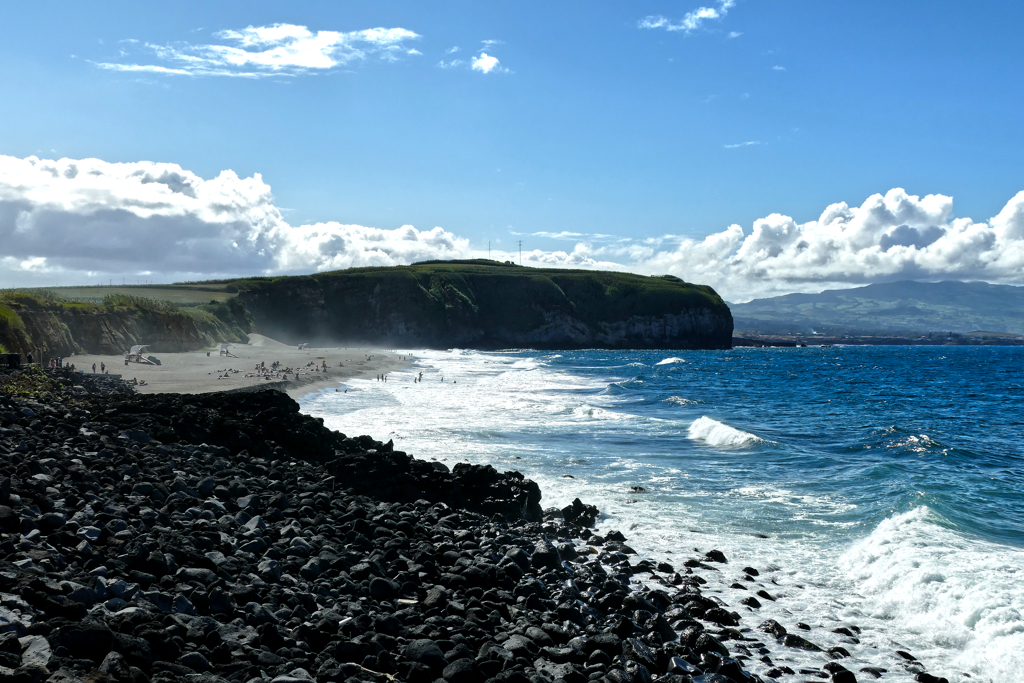
Although Santa Bárbara is well-equipped with amenities, including showers, changing facilities, as well as a restaurant and beach bar, you have to keep in mind that a coast that is ideal for surfers is rarely convenient for those who want to relax on the beach and just go for a leisurely swim. And although there’s a lifeguard on duty during peak season, I find the waves too rough for swimming. Also, the strong breeze that’s fantastic for surfers will basically sandblast you while you try to relax on your beach towel. Nevertheless, it’s being said that the summer months offer better conditions for beachgoers as the weather is warm and the waves are often milder compared to winter.
Chá Gorreana And Chá Porto Formoso
São Miguel Island is home to tea plantations with two main estates, Gorreana and Porto Formoso. These plantations produce teas in a way that is deeply intertwined with the island’s history, culture, and volcanic soil. This soil and the subtropical climate of São Miguel provide ideal conditions for growing tea, giving it a unique taste profile. The island’s climate and the lack of pests allow for natural, pesticide-free cultivation, making the tea both organic and environmentally friendly.

To this date, both plantations use original 19th- and 20th-century machinery to sort, dry, and roll the tea leaves. The traditional production process remains largely unchanged, adding to the authentic experience during the visit.
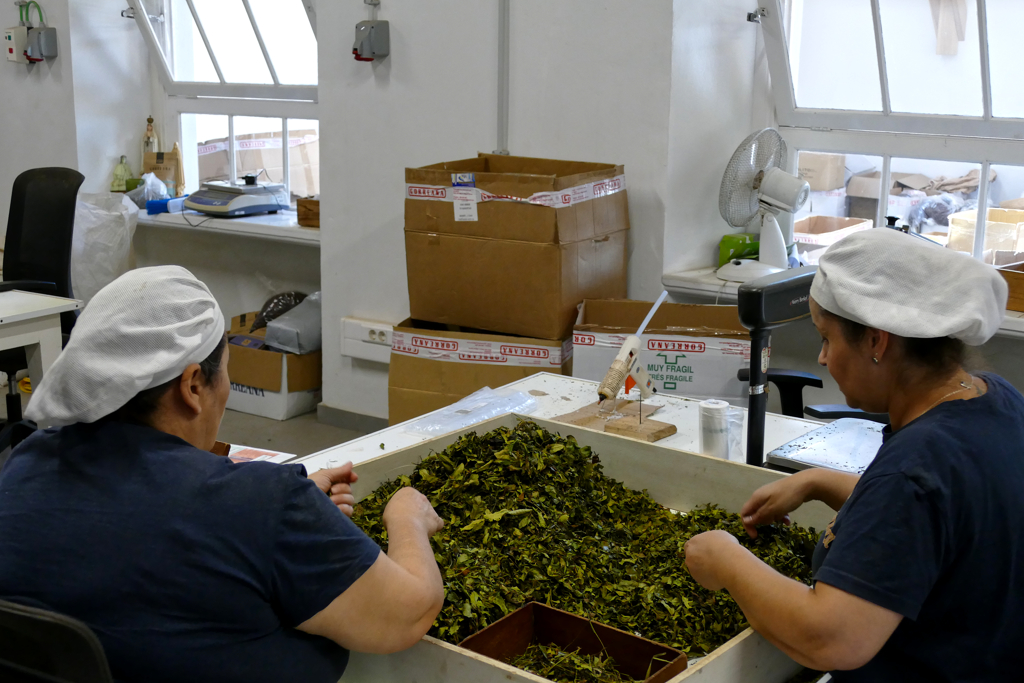
Established in 1883, Gorreana is still family-owned. Spanning over 32 hectares, the estate has extensive fields of green tea bushes set against the backdrop of the Atlantic Ocean.
The plantation primarily produces black and green teas, which are known for their light and subtle flavors.
You can walk through the factory to see traditional tea-processing machinery in action on a free tour. At the end, you get to sample teas and enjoy a walk through the scenic fields.

Although smaller than Gorreana, Porto Formoso also has a rich history. The factory is known for preserving traditional tea-making methods, and its teas are often characterized by a slightly richer flavor profile than Gorreana’s. Visitors can also enjoy guided tours, tastings, and even tea-picking experiences.
Plan Your Visit
Both tea plantations offer not only a sensory experience through tastings but also a deeper look into the agricultural heritage of the Azores. Whether you’re a tea enthusiast or simply curious about Azorean traditions, visiting these plantations is a memorable way to experience São Miguel.
You can get to either of the farms by public bus straight from Ponta Delgada or including a stop in Ribeira Grande.
Chá Gorreana opens weekdays from 8 a.m. to 6 p.m., and on weekends, they open only at 9 a.m.
Chá Porto Formoso is open from Monday to Saturday between 9 a.m. and 6 p.m.
Both estates have cafeterias as well as shops.
Going West: Sete Cidades, the Most Iconic Sceneries
In Peru, they have the mystical mountains of Machu Picchu. The US has the Grand Canyon, and Norway has Trolltunga. We have seen hundreds of pictures of these mythical places, and yet, seeing them with our own eyes on the spot is way up high on our bucket lists.
Sete Cidades is one of those legends.

It’s not just the beauty of Sete Cidades, which means Seven Cities in English, that is fascinating. The story of its origins is no less impressive.
The volcanic complex is an unimaginable 210,000 years old. The caldera was created by a large eruption of magnitude 5 on the volcanic explosiveness index 22,000 years ago. Eventually, there were at least twenty more eruptions. The volcano has been one of the most active in the Azores over the last 5,000 years.

The lake consists of two parts connected by a narrow channel. Winding roads and lush hydrangea-lined paths lead you to the crater rim, from where you have an amazing view of the entire caldera. If you look down about 500 m from the perimeter, one lake appears blue due to the reflection of the sky and is appropriately called Lagoa Azul. The other part gives the vegetation behind it a shimmering green color and is therefore called Lagoa Verde.
On the west bank is the town of Sete Cidades. In the 1930s, a tunnel was built to better regulate the water level in the lakes and prevent flooding in neighboring towns.
Plan Your Visit
Although it’s possible to get to the village of Sete Cidades by public bus, for instance from Ponta Delgada, I strongly recommend joining an organized tour if you don’t have your own vehicle. Not only are the bus connections very sparse. The bus leaves you in the village from where you then have to walk. This way, you cannot enjoy the lakes from different angles as the viewpoints are located quite far from each other.
An organized tour also takes you to other alluring spots like the viewpoint Miradouro do Pico do Carvão, the Lagoa do Fogo, as well as the northern coast. The price for the tour not only includes the assistance of a knowledgeable guide but also a delicious lunch. Here you can check out which of the tours suits you the best*:
Fun Fact
According to a legend, the different colors came about when a princess and her lover, a shepherd, had to separate. Her tears formed the pools in the colors of her eyes.
Going East: Furnas, a Real Hotspot
In addition to the Sete Cidades in the west of São Miguel, there are also natural wonders in the east that you should not miss when visiting the island. Furnas is located about 45 kilometers from Punta Delgada. It is a picturesque city known for botanical gardens and mineral springs, but primarily for geothermal activity in the surrounding area. It is located in a volcanic crater, which makes it a literal hotspot for nature lovers and those seeking relaxation.

Although the bus service from Ponta Delgada to Furnas is pretty good, I would strongly recommend joining an organized tour if you don’t have your own vehicle. It’s easy to get into the town of Furnas, however, from there, you can only reach all the attractions in the area on long walks on foot. Also, on the way to Furnas, the tour buses make brief stops at places where the public bus doesn’t stop, such as the Miradouro do Pisão, from where you have a grand view of the coast around Caloura and Vila Franca do Campo, where you can sample the local pastry Queijadas do Morgado.
Public transport is simply not suitable for such pleasant pit stops.
Here you can see which excursions are available and what they include:
Parque Terra Nostra
Hiking scenic trails, exploring the volcanic terrain, forests, and viewpoints overlooking the lake – there are tons of things to do in the municipality of Povoação, where Furnas is located. The most popular activity, however, is a visit to the Terra Nostra Garden, which is conveniently located in the center of town. It is one of the most famous botanical gardens in the Azores and is renowned for its diversity of flora, especially azaleas, camellias, and endemic plants. Founded in the 18th century, this park is a peaceful retreat, with a large iron-rich geothermal pool at its center.

It is the garden’s most famous feature. The pool’s distinctive yellowish-brown hue is due to the mineral content, especially iron, which is considered therapeutic for skin and muscle relaxation. Visitors can dare a soak here. The pool temperature generally stays around 38°C, which makes even longer soaks enjoyable. Surrounded by the garden’s lush greenery, the pool feels like a natural SPA. Towering trees, flowering plants, and tropical foliage frame the pool, creating a serene environment.

I dare you: Are you coming in?
A bath in the pool is included in the entrance fee. Terra Nostra Garden provides changing facilities and showers. Nevertheless, be careful with your clothes and other belongings as the waters might not only dye your favorite swimsuit brown. If you don’t shower very thoroughly after your soak, residues from the water might still be on your skin and stain your clothes.
A Walk in the Park
While the pool with its spooky water is definitely the main attraction, don’t forget that Terra Nostra Garden is home to an extensive array of plants from around the world, including rare and exotic species. Particularly impressive is their camellia collection, which is especially beautiful in early spring.

You’ll find the garden’s 2,000 types of trees and plants divided into different sections like tropical plants, endemic Azorean flora, and a Japanese garden. Each of these has a unique atmosphere to them.

In general, the park’s design is a blend of European garden styles and local elements, influenced by the tastes of successive owners over the centuries. Winding paths take visitors through different sections. Several pathways are shaded by canopies of tall trees, creating a serene atmosphere ideal for leisurely strolls. In addition, there are various ponds, bridges, and pavilions.

The Terra Nostra Garden is open every day from 10.30 a.m. to 4.30 p.m. and the general entrance fee is 16 €uros.
Fumarolas Lagoa das Furnas
As I said, while the Parque Terra Nostra is pretty awesome, there’s more to explore in and around Furnas. The village is literally scattered with so-called fumaroles. These are hot steam vents where geothermal energy bubbles up from below the Earth’s surface. Sulfurous gases and steam give off a distinct scent and create a landscape that looks almost otherworldly.

The most outstanding tradition in Furnas is cooking the dish Cozido das Furnas using geothermal heat. To prepare this stew, various meats, potatoes, and vegetables are placed in large pots. These are then buried in the hot ground near the fumaroles. The stew slow-cooks for several hours in the natural heat, developing a wonderful flavor infused by the volcanic earth. Restaurants around Furnas serve Cozido prepared with the area’s geothermal energy.
However, Furnas also has over twenty mineral springs with naturally carbonated water. Each has a unique composition and taste due to varying mineral contents. Some are warm, others cold, and each spring is said to have distinct health benefits.
You can sample the waters right from public fountains.

Since I’m a culinary daredevil, I actually drank from one of the fountains. It was an interesting experience, but I admit that I didn’t like the metallic aftertaste.
Hence, for me, the boring bottled stuff, por favor.

The contrast between the lush greenery of Furnas’ valley and the raw power of the geothermal vents makes it one of the most impressive spots in the Azores.
Therefore, Azorean authorities have implemented measures to protect these geothermal areas, ensuring they remain sustainable and ecologically healthy.
Practical Information
How to Get There
By Plane
The Aeroporto João Paulo II Airport, named after Pope John Paul II, obviously, is located five kilometers west of Ponta Delgada’s city center. It is the largest airport in the Azores and the headquarters of the regional airline SATA Air Açores. In addition to regional routes, there are scheduled and charter flights to North America and Europe.

If you don’t rent a car right at the airport, you need to get to your final destination by cab. Note that cabs are not metered, but rather have fixed prices. Those start at ten €uros and vary depending on the distance. Don’t worry, there’s no need to haggle as price boards are listing all possible locations across the island.
By Ferry
The call came around half past nine in the morning: “Hello, I’m calling from Atlânticoline. Your ferry can’t get to Graciosa this evening. Do you want to travel with us in three days, or should we reimburse you for the ticket?”
Uh – neither!
I have planned to take the ferry to São Jorge this evening, my hotel is booked, and my suitcase is packed. But my planning doesn’t move the very professional lady on the phone one bit.
We hang up, and I get in a frenzy to book a flight as quickly as possible, at least for the next day.
I got the last seat on the morning flight.

Don’t get me wrong: ferries offer a scenic and often inexpensive way to travel between the Azores. This mostly works very well, especially within the central archipelago, as the islands there are close to each other. Yet, if you are flexible and willing to adapt to seasonal schedules, you can basically travel to all the islands by sea. Especially from June to September, the connections are more frequent and most islands are served daily. However, it is advisable to book ferry tickets in advance, especially during these months, as ferries are often fully booked.
But always remember that ferry connections are heavily dependent on the weather. Especially in autumn and winter, trips can be canceled at short notice due to strong winds or high waves.
I can tell you a thing or two about it.
It is advisable to find out about the current departure times shortly before the start of your trip. Atlânticoline provides current timetables and booking options on their website.
Also, they will call you if your ferry can’t dock, trust me.
How to Get Around
Public transportation in São Miguel is available but somewhat limited to say the least. Two major bus companies serve the island. Bus routes mainly connect the main cities, although the frequency of buses varies considerably. Routes connecting larger cities such as Ponta Delgada with Ribeira Grande or Vila Franca do Campo operate more frequently than those to smaller villages. Some buses only run a few times a day or even just a few days a week. Therefore, public transport works reasonably well if you are based in Ponta Delgada and only want to visit the main cities. However, I don’t see why anyone would like to do that, as the true attractiveness of the island lies in its great outdoors.

Several minibus routes operate within the city limits of Ponta Delgada. Although they are reliable, their routes are often crazy and comprehensively extended as they move in strange circles. I kid you not, it is often much quicker to walk than to sit on a bus that goes around in circles over and over again before reaching the desired destination.
On the positive side, tickets are very affordable. The city bus only costs 50 cents, and because of the crazy routes, you definitely get your money’s worth. You can pay cash on the bus.
If you’re willing to explore the island at a slower pace, you can rent a bicycle or an e-bike. However, keep in mind that the island’s hilly terrain can be extremely challenging!
Organized Trips
“The situation with public transport is really very bad. You can’t explore the island by exclusively using public transport!”
How many times have I heard this warning, and it has never put me off. Whether Martinique or Curaçao – through good planning, I always managed to visit the places I wanted to see by public bus. Only very rarely have I had to give up my plans.
The Azores are, unfortunately, one such case.
Despite being Portuguese territory and therefore part of Europe, a continent that can be proud of its public transport networks, the situation in the Azores is deplorable. Relatively few routes are served and sometimes only once a day. Sundays are a complete day of rest on most islands. It’s despairing.
So if you don’t rent your own vehicle and don’t want to spend hours figuring out complicated connections, it’s best to join an organized day trip. I don’t say this lightly, I really searched meticulously for convenient connections.
Unfortunately, it was in vain.
However, while in the past, I mainly joined organized day trips from time to time when there was no convenient public transport option, I now do it for safety reasons. Believe me, you do not want to sit by yourself in the wilderness with no opportunity to call for assistance as I did during a hiking accident in Gran Canaria. Therefore, take at least a hiking buddy with you, especially when exploring impassable and rough terrain.
Or, even better, go with a knowledgeable local guide.
No matter your reason for wanting to join an organized excursion, here are some great options for exploring São Miguel on guided tours*:
Where to Stay
Since the Azores are still more of a travel destination for real connoisseurs, the selection of accommodation options is significantly smaller than on the Portuguese mainland or other European archipelagos such as the Canary Islands.
As São Miguel is the most touristically developed island in the Azores, there are even some of these charmless large hotels here. Nevertheless – or perhaps because of this – it is much more difficult than on most other islands to find relatively reasonable accommodation. This applies not only to large hotels, but even to privately arranged Airbnbs.
Therefore, I recommend booking early, especially if your budget has a certain limit.
This map should help you find a convenient lodging option according to your liking and budget*:
What to Eat
São Miguel offers a unique culinary scene that blends Portuguese heritage with local ingredients, many of which thrive in its lush volcanic soil. Therefore, what’s absolutely not to miss is the so-called Cozido das Furnas. It’s a traditional stew of meats like beef, pork, chicken, sausages, and vegetables such as potatoes, carrots, cabbage, and sweet potatoes.

What makes it so special is that it’s cooked using geothermal heat in the volcanic earth around Furnas. The stew is buried underground near the hot springs and left to slow-cook for hours. The result is a tender, flavorful dish infused with a subtle sulfur aroma from the volcanic steam.
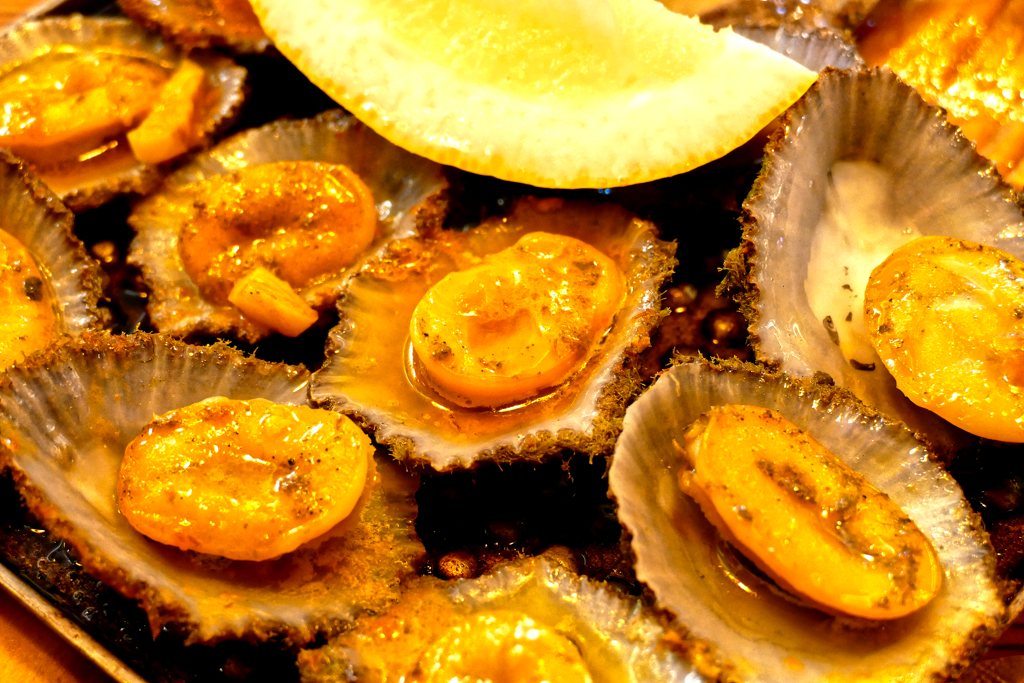
Although the Azores’ Atlantic waters provide less seafood than you might expect, there are still various popular dishes. However, note that fish is far more expensive than meat. Popular seafood dishes are for instance Polvo Guisado, octopus stewed in wine, tomatoes, onions, and garlic, and Lapas, grilled limpets.

If you like your food crispy and crunchy, try some carapau frito. You might know it from the Portuguese mainland where it’s called jaquinzinhos. Carapau frito is typically prepared from young mackerel which is fried until crispy and golden brown. They are served and enjoyed whole including the head, bones, and tail.
What’s For Dessert?
Well, definitely local pineapple! Grown in greenhouses and with a slightly tart but very sweet flavor, Azorean pineapples are a world apart from the usual variety. However, the Azores are also known for a variety of tropical fruits, including passionfruit, bananas, and guava, all smaller and more intense in flavor than those grown elsewhere. They are often used in cakes as well as a topping for yogurt or ice cream.
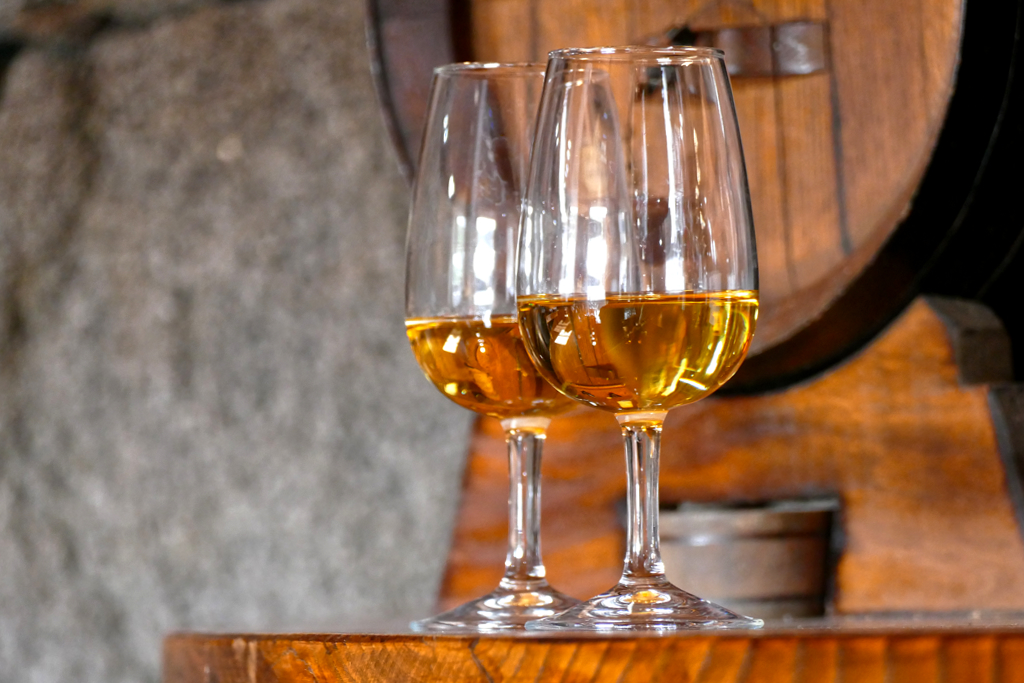
Artisan cheeses are another regional specialty, especially the ones from São Jorge. It’s a semi-hard, spicy cheese made from cow’s milk, aged for at least three months. Its sharp, tangy flavor and creamy texture make it an ideal pairing with local bread or a glass of wine.
Talking ’bout bread: Bolos Lêvedos are fluffy flatbreads. They are versatile and eaten with Azoran cheese or Linguiça, a spicy sausage. Although I’m a huge bread eater, I must admit that I’m not a big fan of Bolos Lêvedos as they always have a sweet-ish aftertaste.
The wine you’re enjoying with local cheeses should also come from Azoran vineyards, obviously. Volcanic wines are produced mainly on the islands of Graciosa and Pico Island. UNESCO even listed Pico’s vineyard as a World Heritage Site.
Cash and Cards
Until now, 21 European countries replaced their former local currency with the €uro starting in 2002. Obviously, Portugal is one of them. The exchange rate is 1 US$ = 0.85 EUR as of September 2025. However, you can check today’s conversion rate on this page.
You can pay by credit card at basically every business. Nevertheless, you’ll need cash for the bus and at the farmers’ market.
Language
Language and communication in the Azores are deeply rooted in the region’s history, geography, and culture. The official language is Portuguese, obviously.
Many of the settlers who colonized the islands in the 15th century were from various regions of Portugal, where older forms of Portuguese were spoken. Therefore, you can still find remnants in the Azorean dialect. As a matter of fact, each of the nine islands has variations in accent, vocabulary, and pronunciation, making Azorean Portuguese quite diverse. Despite these differences, speakers from the islands can generally understand each other, and the dialects are still part of the broader Portuguese language family.
The Azores have a significant history of emigration, particularly to the US, Canada, and Brazil. Therefore, in communities with strong ties to emigrant families, many Azoreans speak both Portuguese and English. In fact, English has become a secondary language in some areas due to the large Azorean diaspora in English-speaking countries. Also, due to international tourism, basically everyone working in that field speaks English more or less fluently.
Nevertheless, if you want to learn some basic Portuguese or just brush up on your knowledge, there are various apps and online tools. I personally like to practice with babbel.
Connection and Communication
Since June 2017, no roaming charges have applied within the EU with a European mobile phone contract. This applies to all 27 countries of the European Union as well as Iceland, Liechtenstein, and Norway. It pertains to all contracts.
When roaming is not available, you can connect to the internet basically everywhere.
If you insist on being online 24/7, you can get a SIM card. For the best network coverage and balance of data options, MEO is considered the top choice for tourists visiting the Azores, especially for travelers heading to more remote islands. They offer prepaid SIM cards for tourists, MEO Go being the best option for tourists. You can get 15GB of data for 15 €uros, valid for 15 days. After that, you can top up, obviously.
MEO SIM cards can be purchased at Lisbon or Porto airports, in case you’re arriving in mainland Portugal first. Otherwise, you can get them at MEO stores across the Azores.
Other popular companies are Vodafone, NOS, and Lycamobile.
In Portugal, they use plug types C and F. Their voltage is 230 V and the frequency 50 Hz. Whereby, as nowadays all these chargers have integrated adapters, in general, the voltage and frequency don’t really matter.
By the way, you’ll find comprehensive travel info in my post World’s Most Complete Travel Information – an indispensable globetrotter classic.
Map
On this map, you can see where to find all the places I’m mentioning in this post. Clicking on the slider symbol at the top left or the full-screen icon at the top right will display the whole map.
São Miguel was only the first stop of my amazing island-hopping of the Azores. To read about the others, go to the main post and take your pick! There, you’ll also find further valuable general information that will make your own trip much smoother and more enjoyable.
Pinnable Pictures
If you choose to pin this post for later, please make sure to use one of these pictures:






Note: I’m completing, editing, and updating this post regularly – last in September 2025.
Did You Enjoy This Post? Then You Might Also Like These:
24 hours in PORTO
Best Street Art in LISBON – Part II: Marvila
PICO – the Top of the Azores
Guide to COIMBRA. On the Beauty of Knowledge
Best Things to Do in SAO MIGUEL, the Most Varied Island of the Azores
Railroad Trip PORTUGAL
A Day in Sophisticated ESTORIL and CASCAIS
Best of PORTO – Also if You Travel Solo
* This is an affiliate link. Hence, If you book through this page, not only do you get the best deal. I also get a small commission that helps me run this blog. Thank you so much for supporting me!




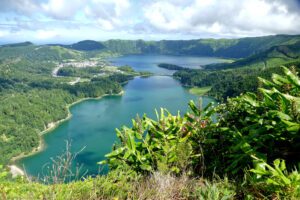

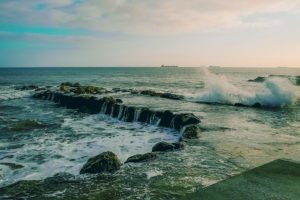

whoah this blog is wonderful i love reading your articles. Keep up the good work! You know, a lot of people are searching around for this kind of elaborated travel info, you certainly help them greatly!
Thank your for your kind words – your encouragement is deeply appreciated 🙂
Your blog has become an indispensable resource for me. I’m always excited to see what new destinations you have to offer. Thank you for consistently delivering top-notch content!
Thank your for your kind words – your encouragement is deeply appreciated 🙂